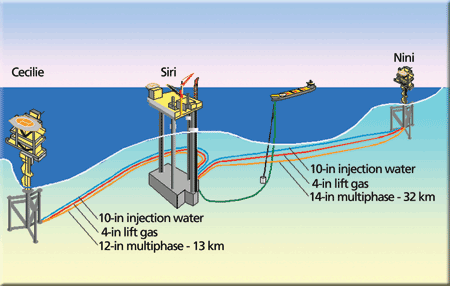Oil production is a fiercely competitive business. Because oil deposits are finite resources, the leased area becomes quickly and densely populated with drilling platforms and production, including pumping and transporting operations. To maximize productivity of each oil platform, all aspects of production involving monitoring and control of repetitive function need to automate. Operating an oil and gas extraction facility offshore presents a list of difficulties. The marine environment is highly corrosive, meaning any platform erected will require intensive maintenance and upkeep platform are typically located in 150 to 350 feet of water, up to 10 miles offshore. The platforms usually must drill several thousand feet below the ocean floor to reach oil and gas deposits. When high seas and heavy winds or hurricanes approach a platform, crew must evacuate to prevent injury or loss of life. To future this end, labor-intensive, repetitive tasks such as opening and closing valves, monitoring levels etc must be automated. The obvious benefits are to reduce cost and ensure timely completion of tasks. The programmable logic controller (PLC) serves extensively to continuously monitor and handle routine operations. The PLC allows valve status; fluid levels, and also allows a platform to shutdown during emergency and thus avoids damage to the equipments. Thus PLC's are widely used in oilrigs.
Drilling for oil is one of the greatest technological
breakthroughs in recent decades, once oil or gas is discovered, a production
platform will replace the offshore drilling rig, which is assembled at the
location using heavy lift cranes situated on a barge. These production
platforms come in a variety of sizes, shapes, and types, which depend on the
dimensions of field, the depth of the water and how far the oil and/or gas
field is from shore. Usually the
platforms are typically located in 150 to 350 feet of water, up to 10
miles offshore. These platforms are generally made of steel and fixed in the
seabed with steel “post”. These platforms harbor the entire well and can house
a maximum of 80 workers. In addition platforms have concrete structure large
enough to store oil, with gravity keeping them situated on the seabed.
Weather is a major factor in platform
operation. When high sea and hurricanes approach a platform the crew must
evacuate to prevent injury or loss of life. Thus safety is an important factor
as far as an oilrig is concerned. Oil and gas production must continue on an
uninterrupted manner to ensure profitability. To further this end, labor-intensive,
repetitive task such as opening and closing valves, monitoring levels, and shut
down of platform to prevent equipment damage are handed over to programmable
logic controllers (PLC’s).
A PLC is a special
form of microprocessor-based controller that uses a programmable memory to
store instructions and to implement functions such as logic, sequencing,
timing, counting, and arithmetic in order to control machines and processes.
When the PLC is programmed, the controller then monitors the inputs and outputs
according to this program by turning on\off its output. PLC’s have the great advantage that the same basic controllers
can be used with the wide range of control systems. To modify a control system
and the rules that are to be used, all that is necessary is to change the
program. There is no need to rewire. PLC’s are similar to computers but whereas
computers are optimized for calculation and display task, PLC’s are optimized
for control tasks and industrial environment. The primary reason for using
PLC’s is to eliminating the large cost involved in replacing the complicated
relay based machine control systems. Such a control system is called a relay
sequencer or relay logic panel.
In earlier days
of industrial control process, discrete state control where provided by
physical relays to put together a circuit that satisfies the requirement of a
ladder diagram. The ladder diagram technique of describing discrete state
control systems originated from relay logic system that is why the diagram
contains so many relay related terms and symbols. The ladder diagram is still
used because it has evolved into an efficient method of defining the event sequences required in a discrete state
control system. It is important to realize that, relay control each rung of the
ladder is evaluated simultaneously and continuously, because the switches and
relays are all hard wired to ac power. If any switch in ladder change state the
consequence is immediate this is not true in the case of computer based
programmable controllers. The main reason for eliminating relays where due to
its increase in cost involved in replacing the complicated relay based machine
control systems. Since relays are mechanical devices they had fewer lifetimes.
Troubleshooting is also difficult when so many relays where used. When a relay
panel has been wired to implement a ladder diagram for a special purpose, if
the event sequence is to be changed it is necessary to rewire all, or part of
the panel.
Application of today’s controller has gone far beyond simple
control functions. Technology not only the controller more capable but also
more affordable. PLC's have become intelligent decision making machines with a
wide scope of application that ranges from variable control functions, data
acquisition, to report generation and supervisory control. Now days PLC are widely used in offshore
oilrigs in order to prevent injury and loss of life. So human controlled task
such as opening and closing of valves, level monitoring is handed over to PLC.
Safe shut down of the plant at unsafe condition are also handed over to PLC.
Thus PLC assure safety to its best. A new method of control such as SCADA and
MMI has made offshore control more efficient and safer.

0 comments: